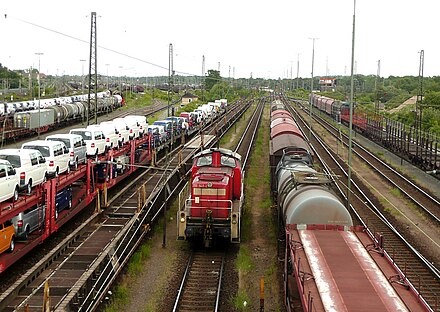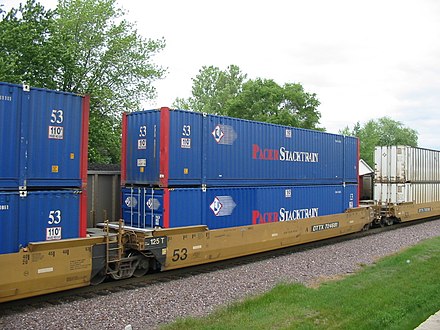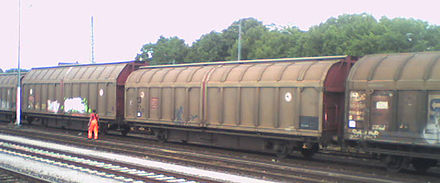Rolling stock
| Part of a series on |
| Rail transport |
|---|
 |
|
|
| Infrastructure |
|
|
| Service and rolling stock |
|
| Special systems |
|
|
| Miscellanea |
|
|

The term rolling stock in the rail transport industry refers to railway vehicles, including both powered and unpowered vehicles: for example, locomotives, freight and passenger cars (or coaches), and non-revenue cars. Passenger vehicles can be un-powered, or self-propelled, single or multiple units.[1][2][3][4] A connected series of railway vehicles is a train (this term applied to a locomotive is a common misnomer).
In North America, Australia and other countries, the term consist (/ˈkɒnsɪst/ KON-sist) is used to refer to the rolling stock in a train.[5]: 1‑129
In the United States, the term rolling stock has been expanded from the older broadly defined "trains" to include wheeled vehicles used by businesses on roadways.[6][7][8]
The word stock in the term is used in a sense of inventory. Rolling stock is considered to be a liquid asset, or close to it, since the value of the vehicle can be readily estimated and then shipped to the buyer without much cost or delay.[9][10] The term contrasts with fixed stock (infrastructure), which is a collective term for the track, signals, stations, other buildings, electric wires, etc., necessary to operate a railway.
Gallery
- Rolling stock
-
Diesel multiple unit (DMU)
-
Electric multiple unit (EMU)
-
Hopper car, one of many types of revenue freight cars
-
Articulated well cars with intermodal containers
-
European covered goods wagons
See also
References
- ^ "Yaxham Light Railway rolling stock page". Archived from the original on 2015-09-20. Retrieved 2007-02-07.
- ^ "Definition of "rolling stock" from the Oxford English Dictionary accessed 5 February 2007 (subscription service)". Archived from the original on 28 September 2020. Retrieved 5 February 2007.
- ^ "Definition of "rolling stock" from the Concise Oxford Dictionary". Archived from the original on March 6, 2007.
- ^ "Definition from the American Heritage Dictionary". Archived from the original on 2009-02-22.
- ^ McAuliffe, Des (1999). "The Snowtown to Port Pirie line". Proceedings of the 1999 convention. Modelling the Railways of South Australia. Adelaide. Archived from the original on 2021-12-12. Retrieved 2021-09-10.
- ^ "Rolling stock". The Free Dictionary. Farlex. Archived from the original on February 23, 2017. Retrieved January 27, 2017.
- ^ Illinois Department of Revenue. "RUT-7: Rolling Stock Certification" (PDF). Archived from the original (PDF) on July 5, 2018. Retrieved January 27, 2017.
- ^ "Michigan's Rolling Stock Exemption". TaxRates. Avalara. Archived from the original on February 2, 2017. Retrieved January 27, 2017.
- ^ Finger, Matthias; Bert, Nadia; Kupfer, David, eds. (2014). "Rail infrastructure and rolling stock: investments, asset renewal and regulation" (PDF). European University Institute, Florence School of Regulation. pp. 8–9. Archived from the original (PDF) on 2017-02-02. Retrieved 2017-01-27.
- ^ Wijnia, Y.; de Croon, J.; Liyanage, J.P. (2014). "36: Application of a Unified Reference Model Across Asset Types: Comparative Cases". In Lee, Jay; Ni, Jun; Sarangapani, Jagnathan; Mathew, Joseph (eds.). Engineering Asset Management 2011: Proceedings of the Sixth World Congress on Engineering Asset Management. London: Springer. pp. 416–417. ISBN 978-1-4471-4993-4. ISSN 2195-4356. LCCN 2013934026 – via Google Books.








